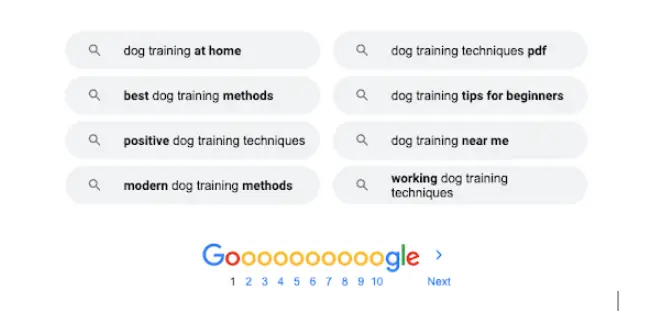Learn the exact SEO copywriting method I used to rank in the top 3 results in Google.

Have you ever found yourself daydreaming about your perfect clients magically finding you?
I often advocate using cold email to pitch clients you’d love to work with. But there’s also a tried-and-true way to help potential clients find your services organically.
Enter the world of SEO copywriting and strategy. 🎯
Search engine optimization (SEO) is the process of helping your website and content rank in search results for the phrases your ideal clients search for.
SEO copywriting is a valuable tool for expanding your own client base. Plus, it’s a sought-after skill you can offer as a service to copywriting clients. But it’s *somewhat* challenging to master – so this article is here to simplify and clarify SEO for you.
I. SEO Copywriting: Definition and Benefits
II. Keyword Research for SEO Copywriting
III. How to Write SEO Content That Ranks Highly in Search
IV. The Role of Analytics in SEO Copywriting
While SEO might seem like a head-scratcher for many folks, I’ve always been really fascinated by it. It’s an awesome way to help a brand grow organically – connecting active search users with the solutions they’re looking for.
But SEO isn’t as flashy as other strategies like social media, so it tends to get left in the dust. That’s why I’m going to show you exactly how to use SEO as a powerful tool to grow a brand.
This is the same method I’ve used to rank in the top 3 results for highly competitive terms like “how to become a copywriter.” Ranking for phrases like this helps hundreds of copywriters find the Write Your Way to Freedom program organically every single month.
Whether you’re aiming to boost your own services, offer SEO copywriting as a service, or a bit of both – you’re in the right place!
Learn How to Build a Lucrative Freelance Copywriting Career
Get my free copywriting masterclass that walks you through exactly how I went from zero to consistent five-figure months with copywriting – with no experience and no portfolio.
Gain instant access – right to your inbox – when you sign up below. 👇
We will never spam you or share your email with anyone. In addition to the guide you’ll also receive semi-regular email updates with tips, tools, offers and exclusive resources. All emails include an unsubscribe link, you may opt-out at any time. Read our Privacy Policy to see how your data is handled.
SEO Copywriting: Definition and Benefits
Let’s take a broader look at what SEO is.
Search engine optimization, or SEO, is the process of using the exact keywords and phrases your audience types into search engines like Google. Using these phrases in your content makes your writing more likely to rank in those search results.
The goal is for your ideal client to see your content when they search for one of these terms.
SEO might feel a bit technical or confusing. But at its core, SEO is simply the process of connecting people actively searching for a solution with a brand’s offer or services.
Here’s an example of SEO in action:
- You just got engaged! Now you’re looking for a wedding photographer.
- You Google the term “wedding photographer in Upstate New York.”
- An engaging blog appears in the first three results.
- You click on the blog that showcases their beautiful gallery.
- You head back to the photographer’s website and it compels you to book a consultation.
Because of SEO, this amazing photographer’s website comes up when you use Google to search for a photographer in their area. Without SEO, you wouldn’t have been able to find them, connect with them, and ultimately get photographs that you absolutely love.
SEO helps people find service providers, brands, and products that benefit them.
The process includes identifying the right keywords to target. And then creating SEO copywriting that’s rich in keywords, value, and relevancy.
A general rule is that anything you want to be found by a search engine should incorporate SEO – like web copy and blog articles. But content that wouldn’t be found by searching online doesn’t need SEO, like emails or sales pages that are part of a funnel.
SEO is *especially* impactful for location-based brands, like the wedding photographer example. But it helps all types of brands, whether location-based or online.
Importance of SEO Copywriting in Digital Marketing
SEO is not quite as flashy as social media, so it’s somewhat of a forgotten strategy. But it actually solves many pain points small brands get frustrated with. Like spending so much time on their marketing or having to churn out content.
SEO is a proven, sustainable, and impactful way to grow a brand organically.
Here are a few of the many benefits of incorporating SEO into a marketing strategy:
- User Intent. Search users are usually actively searching for a solution. This means they’re further along the customer journey and ready to take action.
Let’s say a user enters into Google, “website design services for online brands.” This query is very specific, which shows that the user has a clear need and a target group in mind. They aren’t casually browsing – they’re actively seeking a solution.
- Content Lifespan. Social media content like Instagram reels have an average lifespan of 24-48 hours. This means the brand has to continually create new content to reach their audience. This tends to lead to burnout.
Search platforms like Google and Pinterest offer long-term content visibility. Readers could find one long-form article for years to come. And unlike a social video that requires their face, a brand can outsource their SEO copywriting to an expert like you. - Credibility. Brands are growing their online presence on many platforms, like social media, Podcasts, Youtube, and more. But regardless of where the audience finds you, they still use Google to research the brand.
It’s essential for brands to have a credible presence on Google. When the audience finds high-quality content, they’re more likely to trust the brand as a credible authority. - Free! SEO is a tactic used on the brand’s organic channels. Unlike paid ads, this means they are free for the brand owner to use.
Paid ads are also very effective, so it doesn’t mean that SEO replaces ads. But it gives the brand an additional and long-term source of leads.
SEO builds so much momentum over time. I still receive new client leads and inquiries on my original copywriting website every single month. And the Write Your Way to Freedom website also brings in hundreds of organic visitors monthly.
Website SEO is such a powerful way to grow your audience. But too many small brands simply don’t know how to take advantage of SEO. Or they feel overwhelmed in the process.
As an SEO copywriter and strategist, that’s where you can help.
What Is an SEO Copywriter?
“SEO Copywriting” is a bit of a misleading term. It gives the impression that SEO involves a different style of writing. But the reality is that it’s essentially the same copywriting methods with an added layer of SEO strategy and keyword usage within your text.
Here are the two key elements of SEO copywriting that the rest of this blog will dive into:
- SEO Strategy and Keyword Research. Effective SEO content begins with the critical step of identifying the right keywords to target. This step is more than choosing popular words or phrases. It’s about understanding the language your target audience uses when searching for the products, services, or information you offer.
SEO research involves analyzing search volumes, competition, and relevancy. Then strategically select the keywords that provide the best opportunity for visibility.
This aspect of SEO is an entire process and skill set on its own. It involves continual learning and adaptation as search trends evolve. - SEO Copywriting and Content Creation. Once you’ve identified your keywords, the next step involves using these keywords in your content in a natural and engaging way.
The aim isn’t just to rank highly for these terms but also to provide valuable and relevant information that meets the needs of your audience. High-quality SEO content answers questions, solves problems, and meets the search user’s needs.
While incorporating keywords is important, it’s equally crucial to prioritize high-quality, valuable writing and information. Because these factors also influence how search engines rank your content.
As an SEO specialist, you identify the terms your client’s audience would use to find their offers. Then, you write compelling content rich in keywords and strategy to help that content rank highly for the keyword.
Each skill set is different, but they’re equally important. Effective keyword research is imperative for impactful content – and vice versa. But this whole SEO process often feels nuanced and complex to people.
So, let’s take a deep dive into how to approach each part, starting with keyword research.
Keyword Research for SEO Copywriting
The first step of effective SEO copywriting is keyword research. SEO is most successful when you rank for the terms your client’s audience actually uses to search for the brand.
Ranking for the term “wedding photographer” wouldn’t be impactful for an online business coach. But it could be life-changing for the wedding photographer.
Here’s a breakdown of how to do SEO research for Google:
- Brainstorm a general idea or topic.
Use your own knowledge of your audience to brainstorm topics your audience would be interested in learning about. Feeling stuck? This is a great place to bring in an AI copywriting tool like ChatGPT to brainstorm topics with you.
Keep in mind that the audience might not be searching for the solution you offer – they might be researching their problem. A great thing about SEO is that you can target the problem and then introduce the solution within your SEO content.
For example, if you work in the healthcare space, your readers are much more likely to search for their symptoms. You might target the term “Why am I tired?” and then introduce why testing their nutrient deficiencies could improve their energy. - Check out suggested topics in Google.
Type your topic into Google and see what search results come up. Go to the bottom of the results page to find the frequently searched keywords and questions related to this topic for ideas. Add all these keyword phrases to a list you can refer back to.
For example, let’s say you work with a dog trainer who teaches dog owners techniques they can do independently. Here’s what your SEO copywriting keyword research on Google may look like:
Step 1: Type the topic into Google to see an initial list of related searches.

Step 2: Scroll down to the bottom of the search results page to the “related searches” section.

This list shows your audience is interested in positive dog training techniques and tips for beginners. These two topics can make fascinating blog articles. You could even create a helpful dog training techniques PDF and offer it as an opt-in on the website.
Pro Tip: Install the “Keywords Everywhere” Chrome extension to easily identify additional related keywords.
- Use a keyword planner.
After finding potential keywords in Google, use an SEO planning tool like Ubersuggest to analyze the keyword data. This software shows how frequently certain keywords are searched and how competitive they are.
Type your keyword into the planning tool. Here are the two main numbers to analyze:
Search Volume = An estimation of the number of monthly searches for a keyword.
Keyword Difficulty = Estimation of how hard it is to rank in the top 10 organic results.
Search volume shows you how much potential traffic the site could get if it ranks highly for the keyword. While it’s wonderful lto find keywords high in search volume but low in competition, don’t shy away from competitive keywords.
The most important keywords to target are the ones hyper-relevant to the brand and audience. (Later, I’m going to show you a process for creating high-quality long-form content that ranks above the competition.
- Refine your list to 1 keyword and 3-5 long-tail keywords.
The primary or parent keyword is a broad, generic term that encompasses a large topic or category. For instance, “white shoes” could be a parent keyword.
These terms tend to have high search volumes, but the intent behind them can be unclear as they are very general. On the other hand, a long-tail keyword is a more specific, often longer keyword phrase, like “white cowboy boots with heels.”
Long-tail keywords are more specific and have lower search volumes than parent keywords, but the search intent is much more clear. Aim to target one parent keyword and at least 3-5 relevant long-tail keywords.
Repeat this process for each topic you’re interested in writing about.
If you’re working with a client on their SEO copywriting, it might be helpful to do a large amount of SEO research upfront and map out a 6-month content plan. This condenses your research process and gives you a long-term plan to work towards.
Your SEO keyword research looks slightly different depending on the channel. Google used to be the primary search channel. While Google is still very impactful, there are many other places where people now get access to information – like Pinterest and social media.
I mention this because you could offer SEO for different platforms. Even social channels like Tik Tok are changing their algorithm to perform as more of a search engine. If you’re interested in social channels, advising clients on their social SEO strategy could be a fun part of your package.
But if you’re more interested in Google as your main channel, you can create long-form articles to boost your client’s ranking and beat their competitors.
How to Write SEO Content That Ranks Highly in Search
I’m going to let you in on a little secret about SEO: there’s no exact science or hard-and-fast rules to ranking with SEO. The most effective approach is to try to create the highest-quality content packed with more value than other resources out there.
That’s actually one of the things I love about SEO. Brands can’t “hack” the system – they have to actually provide significant quality and value to the audience.
Here’s the 5-step SEO copywriting method that consistently gets results:
- Analyze front-page results.
Ultimately, your goal is to outrank the existing content on page 1 of search. So, head to Google and read through the top results for your keyword. What are these pieces doing well, and how can you differentiate from them? - Identify information gaps you can fill.
You don’t want to simply regurgitate information. As you read the existing content, consider how you could make your piece even more relevant or helpful. What information are these articles missing that you could include? - Write long-form content.
High-ranking content is usually at least 2,500-3,000 words. Of course, long-form content is more than just having lots of words on the page. But as you add high-quality value, your word count increases and gets longer than the top results. - Incorporate SEO keywords.
Include your primary and long-form keywords throughout your piece. Aim to include them in your title, headings, and paragraphs. But be sure to use them in a natural way that fits with the sentences to avoid keyword stuffing. - Update the backend SEO.
Use SEO keywords within the backend SEO elements, like meta descriptions, page titles, and page URLs. If you’re working with a client on their SEO copywriting, include these items to make it easier for them to incorporate.
There’s one more point that’s not directly tied to ranking for SEO but is very important:
Always include a clear call to action (CTA).
Using SEO helps you get new readers and audiences to your website. But once they’re on the website, you have an opportunity to compel them to take the next action. You always want to consider the question, “How is this traffic translating to engagement and sales for the brand?”
A blog is a powerful place to incentivize the reader to sign up for an email list, book a consultation, or even purchase a small digital product. So, be sure to include the CTA in a clear and compelling way.
The Role of Analytics in SEO Copywriting
Analytics and data tracking is an integral part of offering SEO as a service. Keeping track of site performance tells you what’s working well – and what you might want to try differently.
When you start working with a client on SEO copywriting, you can ask them for access to their Google Analytics to track all this data on the backend. Many clients are happy about you taking this task off their plate.
Here are a few key numbers to look at in Google Analytics:
- Site Traffic: The website’s total number of visits over a given period. This number should steadily grow as you develop and release consistent SEO content.
- Traffic Sources: This information breaks down where your traffic is coming from. Your goal with SEO is to grow the “organic search” traffic specifically. This tells you how many visitors are landing on the site from search engine results.
- Engagement: This metric gives you insight into site visitors’ behavior, like how long they spend on each page. Use this tab to understand how engaging your content is and make adjustments accordingly.
You can also use a keyword planning tool to identify the position that each blog article is ranking for the targeted keyword.
Keep in mind that SEO builds momentum over time. Don’t get discouraged if your page isn’t ranking on page one of Google overnight. And as mentioned earlier, one of the most effective strategies in SEO is revisiting and optimizing your past articles based on their results.
A general rule of thumb is that net-new content usually gains traction in about six months. Whereas updated/optimized content should improve after about three months.
The results also depend on the brand’s current SEO health. If they’re brand new to SEO, seeing results may take longer. The best thing to do is clearly outline these expectations with your clients and keep them updated as you see results.
Become an SEO Copywriter
Using SEO in your content increases the value of your work as a freelance copywriter.
It helps your client’s audience find their content in organic searches, which leads to exposure and site traffic. So when you offer SEO as part of your copywriting, you can charge more – and know that your work is making more of an impact.
Want to dive deeper into how to approach SEO copywriting for clients? Write Your Way to Freedom walks you through every step of the process with over six modules on SEO alone.
- Demystifying SEO and Why It Matters
- How to Do Website SEO Audits
- Killer Keyword Planning
- Operating Google Analytics
- Anatomy of SEO Copy and Content
- Using SEO to Banish Writer’s Block
And SEO is only *one* of the many copy skills you focus on as a Write Your Way to Freedom student. You also learn high-value skills like launch copy, email marketing, SEO copywriting, and more.
Ready to become a highly valuable, highly paid copywriter? Apply for a strategy session to discover if Write Your Way to Freedom is for you!







